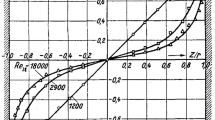Abstract
An internal energy function of the mass density, the volumetric entropy and their gradients at n-order generates the representation of multi-gradient fluids. Thanks to Hamilton’s principle, we obtain a thermodynamical form of the equation of motion which generalizes the case of perfect compressible fluids. First integrals of flows are extended cases of perfect compressible fluids. The equation of motion and the equation of energy are written for dissipative cases, and are compatible with the second law of thermodynamics.
Similar content being viewed by others
Notes
Due to the fact that \(\varepsilon ,_{\rho ,_{x_{j_1}} \ldots ,_{x_{j_p}}} d\rho ,_{x_{j_1}} \ldots ,_{x_{j_p}}= d\rho ,_{x_{j_1}} \ldots ,_{x_{j_p}}\varepsilon ,_{\,\rho ,_{x_{j_1}} \ldots ,_{x_{j_p}}}\) and \(\varepsilon ,_{\eta ,_{x_{j_1}} \ldots ,_{x_{j_p}}} d\eta ,_{x_{j_1}} \ldots ,_{x_{j_p}}= d\eta ,_{x_{j_1}} \ldots ,_{x_{j_p}}\varepsilon ,_{\,\eta ,_{x_{j_1}} \ldots ,_{x_{j_p}}}\), we indifferently permute the position of the two terms in the summation.
For example, when \(A=\left[ \begin{array}{ccc} a_{11}, &{} a_{12}, &{} a_{13} \\ a_{21}, &{} a_{22}, &{} a_{23} \\ a_{31}, &{} a_{32}, &{} a_{33} \end{array} \right] ,\) then
\(\mathrm {div}A=\left[ a_{11},_{x_{1}}+a_{21},_{x_{2}}+a_{31},_{x_{3}},\, a_{12},_{x_{1}}+a_{22},_{x_{2}}+ a_{32},_{x_{3}},\, a_{13},_{x_{1}}+a_{23},_{x_{2}}+a_{33},_{x_{3}} \right] ,\ \mathrm {and}\)
\(\mathrm {div}_{2}\,A={a_{11}}_{,x_{1},x_{1}}+{a_{21}}_{,x_{2},x_{1}}+{a_{31}} _{,x_{3},x_{1}}+{a_{12}}_{,x_{1},x_{2}}+{a_{22}}_{,x_{2},x_{2}}+{a_{32}} _{,x_{3},x_{2}}+{a_{13}}_{,x_{1},x_{3}}+{a_{23}}_{,x_{2},x_{3}}+{a_{33}} _{,x_{3},x_{3}}.\)
References
Van der Waals, J.D.: The thermodynamic theory of capillarity under the hypothesis of continuous variation of density. Translation by J.S. Rowlinson. J. Stat. Phys. 20, 200–244 (1979)
Cahn, J.W., Hilliard, J.E.: Free energy of a nonuniform system, III. Nucleation in a two-component incompressible fluid. J. Chem. Phys. 31, 688–699 (1959)
Gouin, H., Gavrilyuk, S.: Wetting problem for multi-component fluid mixtures. Physica A 268, 291–308 (1999). arXiv:0803.0275
Gărăjeu, M., Gouin, H., Saccomandi, G.: Scaling Navier–Stokes equation in nanotubes. Phys. Fluids. 25, 082003 (2013). arXiv:1311.2484
Gouin, H.: Liquid nanofilms. A mechanical model for the disjoining pressure. Int. J. Eng. Sci. 47, 691–699 (2009). arXiv:0904.1809
Gouin, H.: The watering of tall trees—embolization and recovery. J. Theor. Biol. 369, 42–50 (2015). arXiv:1404.4343
Germain, P.: The method of the virtual power in continuum mechanics—part 2: microstructure. SIAM J. Appl. Math. 25, 556–575 (1973)
Gouin, H., Ruggeri, T.: Mixtures of fluids involving entropy gradients and acceleration waves in interfacial layers. Eur. J. Mech. B Fluids 24, 596–613 (2005). arXiv:0801.2096
Eremeyev, V.A., Fischer, F.D.: On the phase transitions in deformable solids. Z. Angew. Math. Mech. 90, 535–536 (2010)
Rowlinson, J.S., Widom, B.: Molecular Theory of Capillarity. Clarendon Press, Oxford and Google books (2012)
Gouin, H., Seppecher, P.: Temperature profile in a liquid-vapour interface near the critical point. Proc. R. Soc. A 473, 20170229 (2017). arXiv:1703.07302
Casal, P., Gouin, H.: Equation of motion of thermocapillary fluids. C. R. Acad. Sci. Ser. II Mec. Phys. Chim. Sci. Terre Univ. 306, 99–104 (1988)
Maitournam, M.H.: Entropy and temperature gradients thermomechanics: dissipation, heat conduction inequality and heat equation. C. R. Mec. 340, 434–443 (2012)
Bertram, A., Forest, S.: The thermodynamics of gradient elastoplasticity. Contin. Mech. Thermodyn. 26, 269–286 (2014)
Serrin, J.: Mathematical principles of classical fluid mechanics. In: Flügge, S. (ed.) Encyclopedia of Physics VIII/1, pp. 125–263. Springer, Berlin (1960)
Gouin, H.: Noether’s theorem in fluid mechanics. Mech. Res. Commun. 3, 151–156 (1976)
Casal, P., Gouin, H.: Connexion between the energy equation and the motion equation in Korteweg’s theory of capillarity. C. R. Acad. Sci. Ser. II Mec. Phys. Chim. Sci. Terre Univ. 300, 231–234 (1985)
Truesdell, C.: Introduction à la mécanique Rationnelle des Milieux Continus. Masson, Paris (1974)
Acknowledgements
The results contained in the present paper have been partially presented in Wascom 2017.
Author information
Authors and Affiliations
Corresponding author
Additional information
The paper is dedicated to Professor Tommaso Ruggeri.
The work was supported by National Group of Mathematical Physics GNFM-INdAM (Italy).
Rights and permissions
About this article
Cite this article
Gouin, H. Multi-gradient fluids. Ricerche mat 68, 195–209 (2019). https://doi.org/10.1007/s11587-018-0397-5
Received:
Revised:
Published:
Issue Date:
DOI: https://doi.org/10.1007/s11587-018-0397-5



